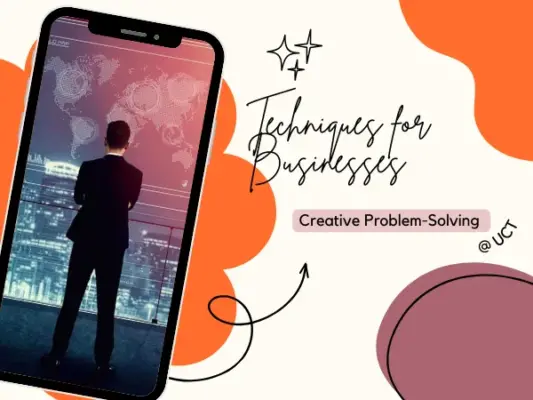
Introduction
In today’s rapidly evolving business landscape, traditional problem-solving methods are often insufficient to address complex and dynamic challenges. Embracing creative problem-solving techniques can help businesses stay ahead of the competition, foster innovation, and overcome obstacles effectively. This blog explores various creative problem-solving techniques that businesses can implement to enhance their strategic approach and achieve better outcomes.
1. Design Thinking
What It Is:
Design thinking is a human-centered approach to problem-solving that emphasizes empathy, ideation, and experimentation. It focuses on understanding the needs and experiences of end-users to create innovative solutions.
How It Works:
– Empathize: Gain a deep understanding of the problem by engaging with users and gathering insights.
– Define: Clearly articulate the problem based on user needs and insights.
– Ideate: Brainstorm a wide range of ideas and solutions without judgment.
– Prototype: Develop simple prototypes to test and refine ideas.
– Test: Collect feedback from users to iterate and improve the solution.
Benefits:
Design thinking fosters innovation by encouraging diverse perspectives and iterative testing, leading to more user-centric and effective solutions.
2. Brainstorming
What It Is:
Brainstorming is a group creativity technique used to generate a large number of ideas and solutions for a specific problem. The goal is to encourage free-thinking and explore all possible options.
How It Works:
– Set a Clear Objective: Define the problem or goal to focus the brainstorming session.
– Encourage Participation: Invite team members with diverse backgrounds to contribute ideas.
– Generate Ideas: Allow free-flowing, unfiltered idea generation, and build on others’ suggestions.
– Evaluate and Select: Review and prioritize ideas based on feasibility and impact.
Benefits:
Brainstorming leverages collective creativity and diverse viewpoints, which can lead to innovative and unexpected solutions.
3. Mind Mapping
What It Is:
Mind mapping is a visual tool that helps organize and structure information around a central idea. It uses diagrams to represent connections between concepts and stimulate creative thinking.
How It Works:
– Start with a Central Idea: Write the main problem or topic in the center of a page.
– Branch Out: Create branches for related ideas, solutions, and sub-problems.
– Add Details: Include additional branches for supporting information and connections.
– Review and Refine: Analyze the mind map to identify patterns and potential solutions.
Benefits:
Mind mapping helps visualize complex problems, uncover connections, and organize thoughts, making it easier to generate and evaluate solutions.
4. SCAMPER Technique
What It Is:
The SCAMPER technique is a structured approach to creative thinking that prompts users to explore solutions by asking specific questions related to the problem. SCAMPER stands for Substitute, Combine, Adapt, Modify, Put to Another Use, Eliminate, and Reverse.
How It Works:
– Substitute: What elements can be replaced or swapped?
– Combine: How can different ideas or components be merged?
– Adapt: What can be adapted from other contexts or solutions?
– Modify: What changes can be made to improve the solution?
– Put to Another Use: How can the idea be used in a different way?
– Eliminate: What can be removed or simplified?
– Reverse: What if the process or solution were reversed?
Benefits:
SCAMPER stimulates creative thinking by encouraging users to explore various aspects of the problem and consider unconventional solutions.
5. SWOT Analysis
What It Is:
SWOT analysis is a strategic planning tool that helps businesses assess their Strengths, Weaknesses, Opportunities, and Threats. It provides a structured framework for evaluating internal and external factors affecting the problem.
How It Works:
– Strengths: Identify internal capabilities and resources that can be leveraged.
– Weaknesses: Recognize areas where the business may be lacking or facing challenges.
– Opportunities: Explore external factors that could be advantageous or lead to growth.
– Threats: Assess potential risks or obstacles that could impact the solution.
Benefits:
SWOT analysis offers a comprehensive view of the problem, enabling businesses to make informed decisions and develop strategies that capitalize on strengths and opportunities while addressing weaknesses and threats.
6. Reverse Brainstorming
What It Is:
Reverse brainstorming is a technique that involves identifying potential ways a problem could be exacerbated or worsened. By considering how to create or worsen the issue, businesses can gain insights into potential solutions and preventive measures.
How It Works:
– Define the Problem: Clearly state the problem or goal.
– Reverse the Problem: Think about how to make the problem worse or what could contribute to its escalation.
– Analyze Causes: Identify underlying causes and contributing factors.
– Develop Solutions: Reverse the negative ideas to generate solutions that address the root causes.
Benefits:
Reverse brainstorming helps uncover hidden challenges and potential pitfalls, leading to more robust and effective solutions.
Conclusion
Creative problem-solving techniques offer businesses innovative ways to tackle challenges, drive growth, and stay competitive. By incorporating methods such as design thinking, brainstorming, mind mapping, SCAMPER, SWOT analysis, and reverse brainstorming, businesses can enhance their problem-solving capabilities and develop effective solutions that lead to success.